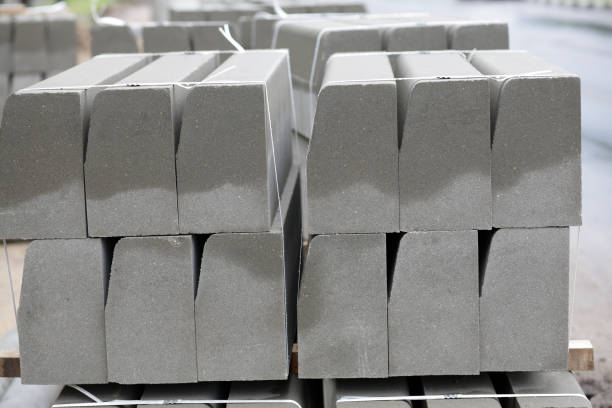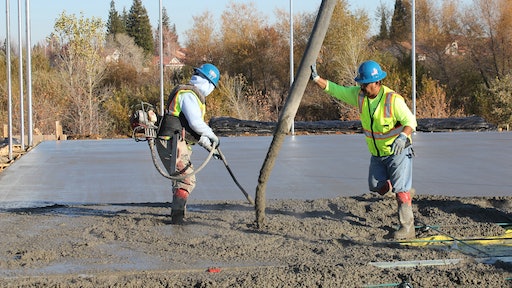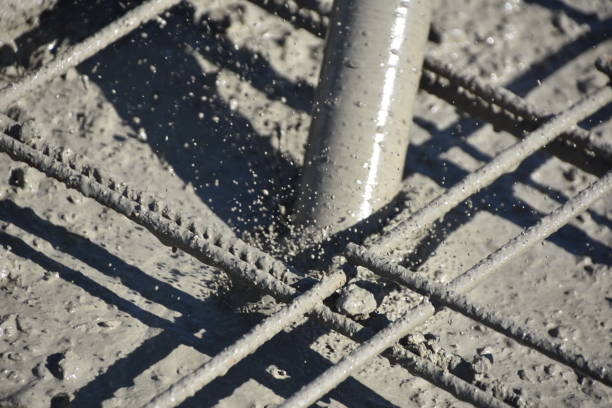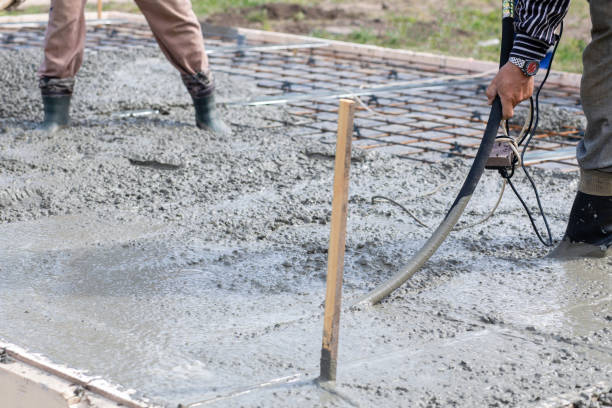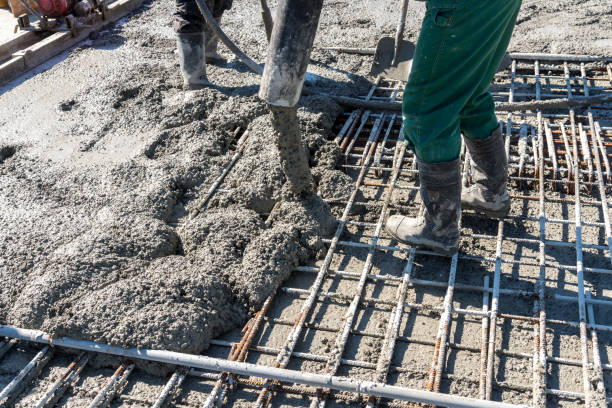Concrete is the backbone of modern construction, but getting it right isn’t as simple as mixing cement and water. To ensure the structural integrity and finish of your concrete project, the use of concrete vibrators is indispensable. In this article, we will delve into the significance of concrete vibrators and how they play a crucial role in the construction industry.
The Significance of Concrete Vibrators
1.What Are Concrete Vibrators?
Concrete vibrators are specialized tools used in the concrete pouring process. They come in various forms, including handheld, electric, pneumatic, and even high-frequency vibrators. These devices are designed to eliminate air bubbles and voids in the concrete mix, ensuring a dense, durable, and smooth finish.
2.Setting the Stage for a Perfect Finish
Concrete vibrators play a vital role in ensuring a smooth surface. Paying attention to every detail, you can set the stage for a perfect finish in your concrete projects. Remember, perfection is in the details, and a well-finished concrete structure not only looks impressive but also stands the test of time.
Understanding Concrete Work
Concrete is the foundation of countless construction projects, and getting the mixing process right is crucial.
Basics of Concrete Mixing
1. Ingredients of Concrete
At its core, concrete is a mixture of three primary ingredients:
Cement: The binding agent that holds the mixture together.
Aggregates: Comprising sand and gravel, these provide strength and volume.
Water: The catalyst that triggers the chemical reaction, making concrete solidify.
2. Quality Control
Quality control is paramount in concrete mixing. Regular testing of the concrete, both on-site and in laboratories, ensures that the mix meets the desired specifications. This is crucial for achieving the desired strength and durability.
The Role of Consistency
Consistency in concrete mixing refers to the state of the mixture—how thick or thin it is. The level of consistency plays a vital role in the workability and final quality of the concrete.
Importance of Air Bubbles
Air bubbles, though seemingly insignificant, can have a significant impact on the quality of concrete.
The Science Behind Vibrations
Concrete, the ubiquitous material in the construction industry, owes much of its strength, durability, and quality to a seemingly simple yet profoundly scientific process: vibrations.
How Vibrations Affect Concrete
Vibrations are more than mere physical phenomena; they are the architects of strong, resilient concrete structures. Understanding how vibrations affect concrete is fundamental to appreciating the role they play in construction.
1.The Compaction Process
Concrete compaction is the process of removing air voids from the mixture to ensure it’s uniformly distributed within the formwork. Vibrations are the tools that make this possible by compelling the particles within the concrete mix to move closer together.
2.Eliminating Air Voids
During concrete mixing, air bubbles and voids often become trapped within the mixture. These voids weaken the concrete structure, making it susceptible to cracks and other structural issues. Vibrations come to the rescue by eliminating these air voids, making the concrete denser and more resilient.
3.Increasing Density
Vibrations enhance the density of the concrete, a pivotal factor in its strength and durability. As particles move closer together, the cement paste fills the gaps, resulting in a more compact and robust structure.
Principles of Concrete Compaction
Concrete compaction is more than a mechanical process; it’s a carefully orchestrated ballet of scientific principles. Understanding the principles of concrete compaction is vital for achieving properly consolidated, defect-free concrete.
1.Consolidation Techniques
Various techniques exist for consolidating concrete, including:
Internal Vibration: Achieved using internal vibrators that immerse into the mix.
External Vibration: Employing external vibrators attached to formwork and vibrating from the outside.
Tamping: Using handheld or mechanical tampers for compaction.
Roller Compaction: Utilizing heavy rollers for large-scale projects like pavements.
Reducing Porosity and Weakness
Reducing porosity and weakness in concrete is the holy grail of construction. Understanding how the science of concrete compaction, including vibrations, contributes to this objective is crucial.
1.Porosity and Weakness
Porosity refers to the presence of voids and air pockets within concrete. These voids weaken the material, making it susceptible to damage and deterioration. Weakness in concrete can result in structural failures, a significant risk in construction.
2.Effective Compaction
Effective compaction, often achieved through vibrations, significantly reduces porosity and the associated weakness in concrete. By vibrating the mix, air voids are expelled, and the cement particles fill the gaps, resulting in a denser and stronger material.
3.Long-Term Durability
Properly compacted concrete with reduced porosity is more durable, less prone to cracking, water penetration, and freeze-thaw damage. This enhanced durability is essential for the long-term performance of concrete elements.
Types of Concrete Vibrators
They come in various types, each designed for specific applications. In this article, we’ll explore the different types of concrete vibrators and their unique features.
Internal Vibrators
Internal vibrators are immersed directly into the concrete mix, making them highly effective at removing air bubbles and voids. They are suitable for a wide range of applications, including walls, columns, and slabs.
1. High-Frequency Vibrators
High-frequency vibrators are known for their rapid vibrations, typically ranging from 10,000 to 17,000 vibrations per minute. These vibrators are ideal for high-performance concrete mixes, including self-consolidating concrete, as they help to disperse the particles effectively.
2. Low-Frequency Vibrators
Low-frequency vibrators, on the other hand, operate at a slower pace, with frequencies between 5,000 to 9,000 vibrations per minute. These vibrators are commonly used for traditional concrete mixes and are excellent for consolidating thicker sections of concrete.
External Vibrators
External vibrators are attached to the formwork and vibrate the concrete from the outside. They are particularly suited for larger, flat surfaces where internal vibrators might be less efficient.
Surface Vibrators
Surface vibrators are employed to vibrate the top layer of concrete to achieve a smooth finish. They are especially useful for decorative concrete applications, such as stamped concrete and exposed aggregate surfaces. Surface vibrators come in various forms, including:
Screed Vibrators: These are used to level and smooth freshly poured concrete. They are often handheld or attached to a screed board.
Plate Compactors: These are commonly used for compacting soil and asphalt but can also be employed to settle the top layer of concrete.
Roller Screeds: These consist of a roller tube that is pulled across the concrete surface, ensuring an even finish.
Bull Floats: Bull floats are large, flat tools used to smooth and level the concrete surface.
Benefits of Using Concrete Vibrators
Concrete vibrators are invaluable tools in the construction industry, contributing to the quality, efficiency, and aesthetics of concrete projects.
Improved Strength and Durability
One of the primary benefits of using concrete vibrators is the significant improvement in the strength and durability of concrete structures. Here’s how it works:
Elimination of Air Voids: Concrete vibrators are highly effective at eliminating air voids and entrapped air bubbles in the concrete mix. When left unaddressed, these voids weaken the concrete, making it prone to cracking and structural issues. Vibrations force these air voids to rise and escape, allowing the cement particles to fill in the gaps.
Increased Density: Vibrations result in a denser, more compact concrete structure. This higher density is crucial for the concrete’s long-term strength and ability to withstand loads and environmental factors.
Improved Bonding: Vibrations enhance the bond between the aggregates and the cement paste. This improved bonding contributes to the overall strength of the concrete, making it more resilient against external forces.
Reduction of Weak Points: Concrete vibrators ensure that the concrete is uniformly mixed and consolidated. This uniformity reduces the chances of weak points and inconsistencies in the structure, resulting in a more reliable and durable construction.
Enhanced Aesthetics
Concrete vibrators play a pivotal role in enhancing the aesthetics of concrete surfaces, which is particularly crucial in decorative and architectural concrete work. Here’s how they contribute to visual appeal:
Smoothing the Surface: Vibrations help create a smooth and even concrete surface, which is essential for projects like exposed aggregate and stamped concrete. Aesthetic finishes require a surface free of imperfections, and concrete vibrators ensure this.
Consistency: Vibrations eliminate irregularities and voids on the surface, ensuring that the final appearance is consistent and attractive. This is essential for achieving a visually pleasing result in decorative concrete applications.
Sharp Detailing: In architectural concrete work, intricate details and fine lines are often required. Concrete vibrators facilitate the precise reproduction of these details, ensuring the finished product is not just strong but also visually stunning.
Time and Cost Savings
Concrete vibrators also offer practical benefits related to time and cost savings in construction projects:
Faster Curing: The use of concrete vibrators helps expel excess water from the concrete mix, which accelerates the curing process. This is especially valuable in time-sensitive projects where fast curing is necessary to move on to the next construction phase.
Reduced Repairs: By ensuring the proper consolidation of concrete, concrete vibrators help prevent issues like honeycombing, surface imperfections, and structural weaknesses. This reduces the need for costly repairs and rework after the concrete has set.
Efficient Workability: Vibrated concrete is more workable and easier to shape and mold. This efficiency saves time and labor costs by reducing the effort required during the pouring and finishing stages.
How to Choose the Right Concrete Vibrator
Selecting the appropriate concrete vibrator is essential for ensuring the success of your construction project. The right choice will depend on various factors, from the project’s specific requirements to the power source and the vibrator’s size and weight. In this article, we will explore the key considerations to help you choose the right concrete vibrator for your needs.
Project-Specific Considerations
The first step in choosing the right concrete vibrator is to consider the specific requirements of your project. Here are some project-specific factors to keep in mind:
Project Type: Different projects have varying concrete pouring needs. Are you working on a large foundation, a wall, or a decorative concrete surface? Each of these applications may require a different type of vibrator.
Concrete Mix: The type of concrete mix being used is crucial. High-performance concrete, self-consolidating concrete, or traditional mixes all have unique characteristics that may require specific vibrators.
Concrete Thickness: The thickness of the concrete pour is an important consideration. Thicker sections may need larger and more powerful vibrators to ensure proper consolidation.
Architectural Details: For decorative or architectural concrete work, where aesthetics are critical, you’ll need a vibrator that can provide a smooth finish and maintain fine detailing.
Power Source Options
Concrete vibrators come in different power source options. Each has its advantages and limitations. Consider the following power sources:
Electric Vibrators: Electric concrete vibrators are suitable for indoor projects and areas with a readily available power source. They are known for their reliability, consistency, and minimal maintenance.
Pneumatic Vibrators: Pneumatic vibrators are powered by compressed air. They are versatile and suitable for various applications. They are especially valuable for outdoor projects where electricity may not be accessible.
Hydraulic Vibrators: Hydraulic concrete vibrators are often used in heavy-duty applications. They are highly efficient and offer a high level of force. However, they require hydraulic power sources, making them suitable for specific situations.
Gasoline or Diesel-Powered Vibrators: These portable vibrators are ideal for remote or outdoor construction sites where electricity or compressed air is not available. They offer mobility and flexibility.
Vibrator Size and Weight
The size and weight of the concrete vibrator can impact its usability and efficiency. Consider the following when evaluating size and weight:
Size: Smaller vibrators are more maneuverable and are excellent for tight spaces or intricate projects. Larger vibrators are suitable for larger pours and thicker sections.
Weight: The weight of the vibrator influences its ease of use and operator fatigue. Lightweight vibrators are more comfortable for extended use, while heavier ones may be necessary for compacting thick or heavily reinforced concrete.
Portability: Depending on your project’s mobility requirements, choose a vibrator that is either handheld or attached to a frame or formwork. Some projects may necessitate both types for various stages of construction.
Steps for Using Concrete Vibrators
Concrete vibrators are valuable tools for achieving well-consolidated and durable concrete structures. To use them effectively, follow these essential steps:
Setting Up the Vibrator
Safety Precautions: Begin by wearing appropriate personal protective equipment (PPE), including safety glasses, ear protection, and gloves. Safety should always be a top priority when working with construction equipment.
Inspect the Vibrator: Before use, thoroughly inspect the concrete vibrator for any damage or signs of wear. Ensure that all parts are in working order, and the electrical or power source connections are secure.
Check the Formwork: Examine the formwork or mold where the concrete will be poured. Ensure that it is stable, well-braced, and free from any debris or obstructions that could interfere with the vibrator’s operation.
Select the Vibrator Head: Choose the appropriate vibrator head or tip for your project. The size and type of vibrator head should match the concrete mix and the specific requirements of the construction.
Prepare the Power Source: If using an electric vibrator, ensure that you have access to a power source and that all electrical connections are properly grounded. If using a pneumatic or hydraulic vibrator, ensure the power source is ready and operational.
Inserting the Vibrator into Concrete
Position the Vibrator: Hold the concrete vibrator at an angle, approximately 15-30 degrees from the vertical, and insert it into the concrete mix. The angle helps prevent the vibrator from coming into contact with the formwork.
Start Vibrating: Turn on the vibrator and slowly immerse it into the concrete. Start with a low intensity and gradually increase it as the concrete begins to consolidate. Avoid abruptly forcing the vibrator into the mix, as this can lead to segregation.
Depth and Spacing: Insert the vibrator at regular intervals throughout the concrete surface. The spacing between insertions should be approximately one and a half times the vibrator’s radius of action. The depth should be sufficient to reach the desired compaction depth.
Ensuring Even Distribution
Work Methodically: Move the vibrator through the concrete in a systematic and methodical manner. Overlap the insertion points to ensure even consolidation. Keep a consistent pace as you work.
Observe Air Voids: As you use the vibrator, watch for air bubbles or voids that escape to the surface. These indicate that the consolidation is taking place, and the concrete is becoming denser.
Check for Over-Vibration: Be cautious not to over-vibrate the concrete, which can lead to segregation or other issues. Monitor the concrete’s workability and adjust the vibration intensity as needed.
Proper Removal and Finishing
Gradual Withdrawal: When removing the vibrator, do so gradually and avoid sudden jerking or pulling. This ensures that the concrete is not displaced, and the surface remains smooth.
Finishing: After consolidating the concrete, finish the surface according to the project requirements. This may involve screeding, troweling, or any other finishing technique.
Curing: Once the concrete has been consolidated and finished, it’s essential to follow proper curing procedures to ensure that it attains its desired strength and durability. Apply curing compounds, cover with wet burlap, or use other approved curing methods as per industry standards.
Write at the end
Recap of Vibrator Benefits
Concrete vibrators bring a multitude of advantages to any construction project. They enhance the strength and durability of concrete, resulting in structures that stand the test of time. They also contribute to enhanced aesthetics, ensuring a polished and professional finish. Moreover, by streamlining the concrete consolidation process, they save both time and money, making them a valuable asset on any job site.
Encouragement to Prioritize Concrete Vibrators
As a responsible builder or project manager, prioritizing the use of concrete vibrators is essential. The decision to invest in high-quality concrete vibrators and the training of your team in their correct usage will undoubtedly pay off in the form of superior results and a more efficient construction process. Don’t underestimate the power of these tools.
Achieving a Superior Final Product
Ultimately, the goal in construction is to produce structures of exceptional quality. By prioritizing concrete vibrators and harnessing their benefits, you pave the way for a superior final product. Whether you’re involved in residential construction, commercial building projects, or large-scale infrastructure and roadwork, the proper application of concrete vibrators ensures that your work will stand out in terms of both structural integrity and aesthetics.
In the language of construction, concrete vibrators are the key to success. So, let them become an indispensable part of your construction toolkit, and you’ll find yourself consistently achieving excellence in every project you undertake.
Post time: Oct-12-2023


